True/False
Indicate whether the
sentence or statement is true or false.
|
|
|
1.
|
If the world price for a good exceeds a
country's before-trade domestic price for that good, the country should import that
good.
|
|
|
2.
|
Countries should import products for which they
have a comparative advantage in production.
|
|
|
3.
|
If a worker in Brazil can produce 6 oranges or 2
apples in an hour while a worker in Mexico can produce 2 oranges or 1 apple in an hour, then Brazil
should export oranges and Mexico should export apples.
|
|
|
4.
|
If free trade is allowed and a country imports
wheat, domestic buyers of bread are better off and domestic farmers are worse off when compared to
the before-trade domestic equilibrium.
|
|
|
5.
|
If free trade is allowed and a country exports a
good, domestic producers of the good are worse off and domestic consumers of the good are better off
when compared to the before-trade domestic equilibrium.
|
|
|
6.
|
If free trade is allowed and a country exports a
good, the gains of domestic producers exceed the losses of domestic consumers and total surplus
rises.
|
|
|
7.
|
Trade makes everyone better off.
|
|
|
8.
|
Trade can make everyone better off if the winners
from trade compensate the losers from trade.
|
|
|
9.
|
Trade increases the economic well-being of a nation
because the gains of the winners exceed the losses of the losers.
|
|
|
10.
|
Tariffs tend to benefit consumers.
|
|
|
11.
|
A tariff raises the price of a good, reduces the
domestic quantity demanded, increases the domestic quantity supplied, and increases the quantity
imported.
|
|
|
12.
|
An import quota that restricts imports to the same
degree as a tariff raises more government revenue than the equivalent tariff.
|
|
|
13.
|
Opponents of free trade often argue that free trade
destroys domestic jobs.
|
|
|
14.
|
If a foreign country subsidizes its export
industries, its tax payers are paying to improve the welfare of consumers in the importing
countries.
|
|
|
15.
|
Tariffs and quotas cause deadweight losses because
they raise the price of the imported good and cause over-production and under-consumption of the good
in the importing country.
|
Multiple Choice
Identify the
letter of the choice that best completes the statement or answers the question.
|
|
|
16.
|
If free trade is allowed, a country will export a
good if the world price is
a. | above the before-trade domestic price of the
good. | b. | below the before-trade domestic price of the
good. | c. | equal to the before-trade domestic price of the
good. | d. | none of these
answers |
|
|
|
17.
|
Suppose the world price is below the before-trade
domestic price for a good. If a country allows free trade in this good,
a. | both producers and consumers will
gain. | b. | both producers and consumers will
lose. | c. | producers will gain and consumers will
lose. | d. | consumers will gain and producers will
lose. |
|
|
|
18.
|
| The following table shows the amount of output a worker can produce per hour
in Germany and Poland. | | | | | | Pens | Pencils | | | Germany | 8 | 4 | | | Poland | 8 | 2 | | | | |
Which of the following statements
about free trade between Germany and Poland is true?a. | Germany will export pencils and Poland will export
pens. | b. | Germany will export pens and Poland will export
pencils. | c. | Germany will export both pens and
pencils. | d. | Germany will export pencils but there will be no trade
in pens because neither country has a comparative advantage in the production of
pens. |
|
|
|
19.
|
If the world price for a good exceeds the
before-trade domestic price for a good, then that country must have
a. | a comparative disadvantage in the production of the
good. | b. | an absolute disadvantage in the production of the
good. | c. | an absolute advantage in the production of the
good. | d. | a comparative advantage in the production of the
good. |
|
|
|
20.
|
Refer to Exhibit 6. If trade is not allowed,
consumer surplus is the area
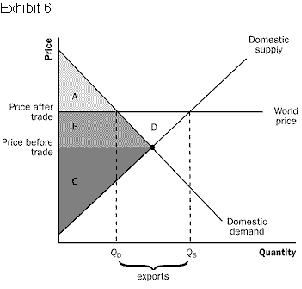
a. | A + B + C + D. | b. | A. | c. | A + B +
C. | d. | A + B + D. | e. | A + B. |
|
|
|
21.
|
Refer to Exhibit 6. If free trade is allowed,
consumer surplus is the area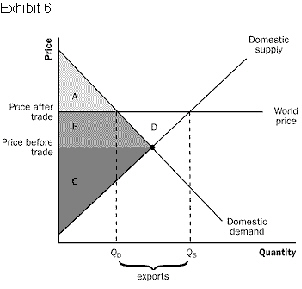
a. | A + B + C + D. | b. | A. | c. | A + B +
D. | d. | A + B + C. | e. | A + B. |
|
|
|
22.
|
Refer to Exhibit 6. If trade is not allowed,
producer surplus is the area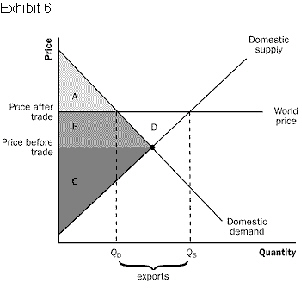
a. | A + B + C + D. | b. | A + B + C. | c. | B + C +
D. | d. | C. | e. | B +
C. |
|
|
|
23.
|
Refer to Exhibit 6. If free trade is allowed,
producer surplus is the area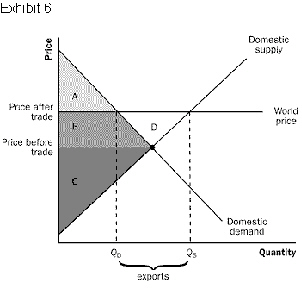
a. | B + C + D. | b. | A + B + C. | c. | B +
C. | d. | A + B + C + D. | e. | C. |
|
|
|
24.
|
Refer to Exhibit 6. The gains from trade correspond
to the area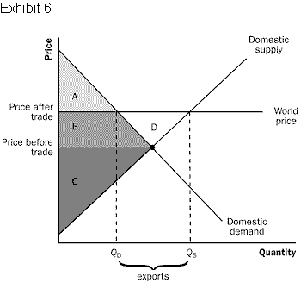
|
|
|
25.
|
When a country allows trade and exports a
good,
a. | domestic consumers are better off, domestic producers
are worse off, and the nation is worse off because the losses of the losers exceed the gains of the
winners. | b. | domestic consumers are better off, domestic producers
are worse off, and the nation is better off because the gains of the winners exceed the losses of the
losers. | c. | domestic producers are better off, domestic consumers
are worse off, and the nation is worse off because the losses of the losers exceed the gains of the
winners. | d. | domestic producers are better off, domestic consumers
are worse off, and the nation is better off because the gains of the winners exceed the losses of the
losers. |
|
|
|
26.
|
When a country allows trade and imports a
good,
a. | domestic producers are worse off, domestic consumers are
better off, and the nation is worse off because the losses of the losers exceed the gains of the
winners. | b. | domestic consumers are worse off, domestic producers are
better off, and the nation is worse off because the losses of the losers exceed the gains of the
winners. | c. | domestic producers are worse off, domestic consumers are
better off, and the nation is better off because the gains of the winners exceed the losses of the
losers. | d. | domestic consumers are worse off, domestic producers are
better off, and the nation is better off because the gains of the winners exceed the losses of the
losers. |
|
|
|
27.
|
Refer to Exhibit 7. If free trade is allowed,
consumer surplus is the area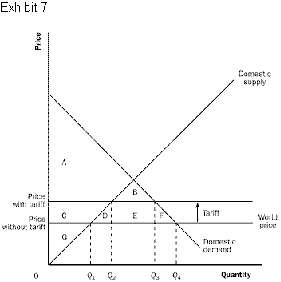
a. | A + B + C + D + E + F + G. | b. | A + B. | c. | A + B + C + D + E
+ F. | d. | A. | e. | A + B +
C. |
|
|
|
28.
|
Refer to Exhibit 7. If a tariff is placed on this
good, consumer surplus is the area
a. | A + B + C. | b. | A + B + C + D + E + F + G. | c. | A + B. | d. | A + B + C + D + E
+ F. | e. | A. |
|
|
|
29.
|
Refer to Exhibit 7. Government revenue from the
tariff is the area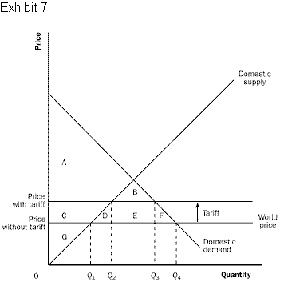
a. | D + F. | b. | G. | c. | E. | d. | D + E +
F. | e. | C + D + E + F. |
|
|
|
30.
|
Refer to Exhibit 7. If a tariff is placed on this
good, producer surplus is the area
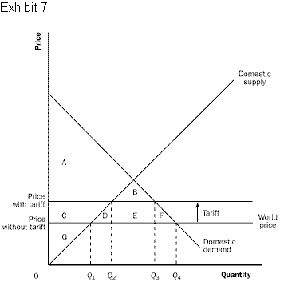
a. | G. | b. | G + C + D + E + F
+ B. | c. | G + C. | d. | G + C + E. | e. | G + C + D + E +
F. |
|
|
|
31.
|
Refer to Exhibit 7. The deadweight loss from the
tariff is the area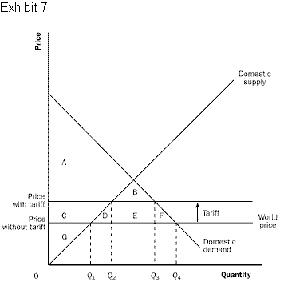
a. | D + F. | b. | E. | c. | D + E +
F. | d. | B + D + E + F. | e. | B. |
|
|
|
32.
|
Which of the following statements about a tariff is
true?
a. | A tariff increases producer surplus, decreases consumer
surplus, increases revenue to the government, and increases total surplus. | b. | A tariff increases consumer surplus, decreases producer surplus, increases
revenue to the government, and reduces total surplus. | c. | A tariff increases producer surplus, decreases consumer surplus, increases
revenue to the government, and reduces total surplus. | d. | A tariff increases consumer surplus, decreases producer surplus, increases
revenue to the government, and increases total surplus. |
|
|
|
33.
|
Which of the following statements about import
quotas is true?
a. | Voluntary quotas established by the exporting country
reduce the importing country's deadweight loss from the trade
restriction. | b. | An import quota
reduces the price to the domestic consumers. | c. | Which of the
following statements about import quotas is true? | d. | Import quotas are preferred to tariffs because they raise more revenue for the
imposing government. |
|
|
|
34.
|
Which of the following is not employed as an
argument in support of trade restrictions?
a. | Free trade harms the national security if vital products
are imported. | b. | Free trade is
harmful to importing countries if foreign countries subsidize their exporting
industries. | c. | Free trade
destroys domestic jobs. | d. | Free trade harms
both domestic producers and domestic consumers and therefore reduces total
surplus. | e. | Free trade harms infant industries in an importing
country. |
|
|
|
35.
|
Because producers are better able to organize than
consumers, we would expect there to be political pressure to create
a. | export restrictions. | b. | import restrictions. | c. | free
trade. | d. | none of these
answers. |
|